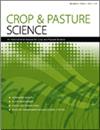Interference of sterile oat (Avena ludoviciana) and Mexican pricklepoppy (Argemone mexicana) in chickpea
IF 1.9
4区 农林科学
Q2 AGRICULTURE, MULTIDISCIPLINARY
引用次数: 1
Abstract
ABSTRACT Context. Knowledge gaps exist for the interference of Avena ludoviciana and Argemone mexicana in chickpea grown in eastern Australia. Aims. This research aimed to examine the effect of different interference levels of A. ludoviciana and A. mexicana for their potential to cause yield loss in chickpea. Methods. Experiments were conducted in a randomised complete block design with five weed infestation levels of both weeds (none, low, medium, high, and very high) in three replications. Key results. Infestations of A. ludoviciana and A. mexicana at 15 and 17 plants m−2 caused an 83 and 48% reduction in chickpea yield, respectively, compared with weed-free situations. Based on the regression model, a 50% yield reduction of chickpea occurred at 10 and 17 plants m−2 of A. ludoviciana and A. mexicana, respectively. Based on the modified hyperbolic model, maximum seed production of A. ludoviciana and A. mexicana in chickpea at an infestation level of 1 plant m−2 was estimated at 366 and 7800 seeds m−2, respectively. At crop harvest, seed retention of A. ludoviciana and A. mexicana was greater than 50 and 90%, respectively. Conclusions. A. ludoviciana and A. mexicana infestation in chickpea caused a substantial reduction in crop yield. High seed retention in A. mexicana and A. ludoviciana in chickpea suggests the possibility to manage these two weeds through harvest weed seed control. Implications. The information generated from this study could help in strengthening integrated weed management in chickpea.不育燕麦(Avena ludoviciana)和墨西哥皮罂粟(Argemone mexicana)对鹰嘴豆的干扰
本文章由计算机程序翻译,如有差异,请以英文原文为准。
求助全文
约1分钟内获得全文
求助全文
来源期刊

Crop & Pasture Science
AGRICULTURE, MULTIDISCIPLINARY-
CiteScore
4.20
自引率
15.80%
发文量
111
审稿时长
3 months
期刊介绍:
Crop and Pasture Science (formerly known as Australian Journal of Agricultural Research) is an international journal publishing outcomes of strategic research in crop and pasture sciences and the sustainability of farming systems. The primary focus is broad-scale cereals, grain legumes, oilseeds and pastures. Articles are encouraged that advance understanding in plant-based agricultural systems through the use of well-defined and original aims designed to test a hypothesis, innovative and rigorous experimental design, and strong interpretation. The journal embraces experimental approaches from molecular level to whole systems, and the research must present novel findings and progress the science of agriculture.
Crop and Pasture Science is read by agricultural scientists and plant biologists, industry, administrators, policy-makers, and others with an interest in the challenges and opportunities facing world agricultural production.
Crop and Pasture Science is published with the endorsement of the Commonwealth Scientific and Industrial Research Organisation (CSIRO) and the Australian Academy of Science.
 求助内容:
求助内容: 应助结果提醒方式:
应助结果提醒方式:


